and historical purposes, all rights reserved.
This page is copyright© by
This page may not be sold or distributed without
the expressed permission of the producer
I have no connection with any camera company.
Chinon CX
AKA: RevueFlex 3000 SL
This camera manual library is for reference
and historical purposes, all rights reserved.
This page is copyright© by ![]() , M. Butkus, NJ.
, M. Butkus, NJ.
This page may not be sold or distributed without
the expressed permission of the producer
I have no connection with any camera company.
On-line camera manual library
If you find this manual useful, If you use Pay Pal, use the link below.
Back to main camera manual page
Chinon CX PDF direct from manual
Chinon CX PDF from HTML file below
how about a donation of
$3 to:
M. Butkus, 29 Lake Ave.,
High Bridge, NJ 08829-1701
and send your e-mail
address
so I can thank you.
Most other places would charge
you $7.50 for
a electronic copy
or $18.00 for a hard to read Xerox copy.
buy new manuals, and pay their shipping costs.
It'll make you feel better, won't it ?
Use the above address for a check, M.O. or cash.

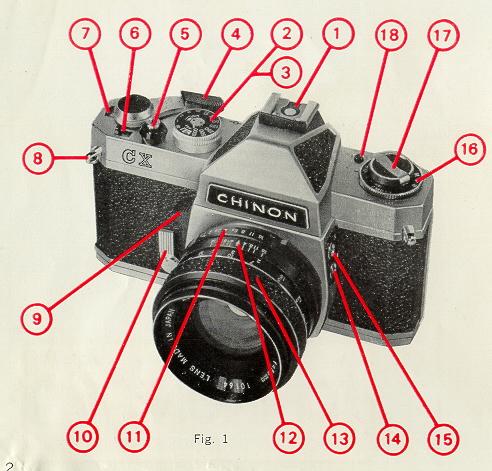
1. Accessory shoe (with direct flash contact)
2. Shutter speed dial
3. Film speed dial (ASA/DIN)
4. Film advance lever
5. Shutter release
6. Multiple exposure lever
7. Exposure counter window
8. Shoulder strap eyelet
9. Exposure-meter switch
10. Self-timer
11. F stop ring
12. Depth of field scale
13. Distance ring
14. M synchro-flash socket
15. X synchro-flash socket
16. Film type indicator
17. Film rewind knob/Film chamber cover opening
18. Battery test button
19. Viewfinder eyepiece
20. Battery test light
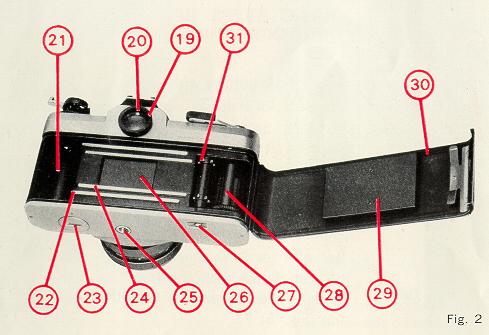
21. Film chamber
22. Film guide rail
23. CdS battery compartment cover
24. Film rail
25. Tripod socket
26. Shutter
27. Rewind button
28. Take-up spool
29. Film pressure plate
30. Film chamber cover
31. Sprocket teeth
IMPORTANT! BASIC STEPS IN PHOTOGRAPHING
(1) Insert CdS battery with plus (+) side up
(2) To test battery condition, Fig. 6 depress the battery test button and observe test light
(3) Load 35 mm film in 20 or 36 exposure cassette
Mercury
batteries are no longer available.
Look for Wein Air batteries as
a replacement.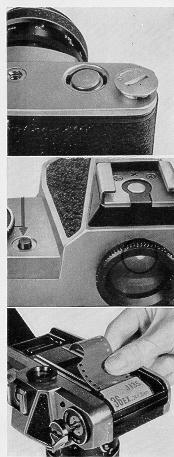
(4) Set ASA (or DIN) speed dial in accordance with the film speed specified on the film box
(5) Set either the shutter speed or lens opening according to your photographic need
(6) Focus the lens
(7) Release the shutter (Fig. 8) 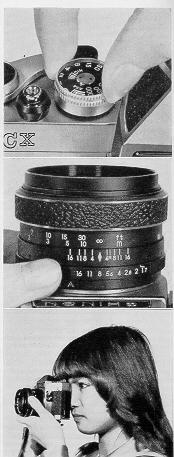
LOADING THE CAMERA
Use 35 mm film in 20 or 36 exposure cassette. It is recommended to load and unload camera in subdued light, e.g. shadow of your own
body and not in direct sunlight.
| (1) Pull up film rewind knob until camera-back pops open. Swing open camera-back | 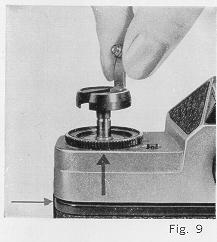 |
| (3) Insert end of film into slot in take-up spool and engage perforation of film with tooth in spool slot. Place thumb lightly over film on bottom sprocket wheel and operate film advance lever until upper sprocket wheel engages film perforations. When advance lever stops, free it by depressing shutter release on top of camera. Make sure that film lies flat between guide rails (Fig. 10). Close camera back firmly. | 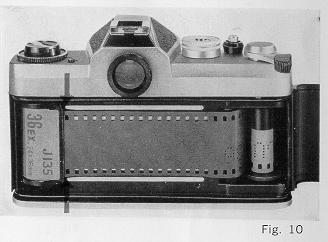 |
| (4) Operate film advance lever, depressing shutter release until figure " 1 " is lined up in the exposure counter window. In this position the camera is ready for the first exposure to be made (Fig. 11). | 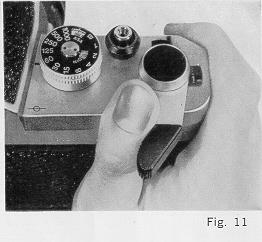 |
| The ASA (or DIN) speed of the film is specified on the film box or in the instruction sheet packed with the film.
Pull up and rotate the outer rim of the shutter dial until desired ASA (DIN) number of the film appears in the window on the top of the film shutter speed dial (Fig. 12). |
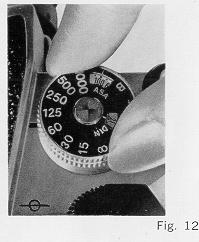 |
| Also rotate film type indicator dial so that the film type inserted shows to its pointer
(Fig. 13). This will remind you of the type of film you are using.
Some ASA (DIN) numbers are represented by a dot only. The chart below specifies the ASA (DIN) numbers. |
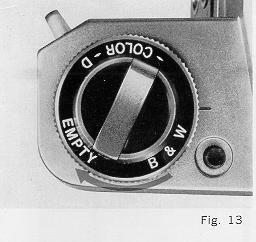 |
|
CORRECT EXPOSURE Correct exposure can be made by setting F stops on the lens and correct combination of shutter speed. As the CHINON CX camera has a built-in through-the-lens CdS exposure meter, you can take correctly exposed photographs. (1) See the subject through viewfinder. Press down the exposure meter switch (Fig. 14). |
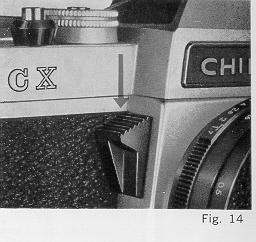 |
| Depending upon the subject, rotate either shutter speed dial or F stop ring until the
exposure indicator needle in the viewfinder comes to the complete horizontal position
(Fig. 15). If the needle is above the horizontal position, it is overexposed (Fig. 16). Change the shutter speed to a faster speed or use a smaller lens opening so that the correct exposure combination can be obtained. If the needle is below the horizontal, it is under exposed so that a slower shutter speed or bigger lens opening must be set (Fig. 17). |
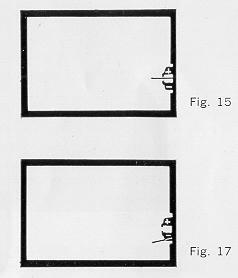 |
| 2) When an ASA setting is used in conjunction with speeds and/or apertures which are beyond the range of the TTL meter a red signal will appear in the exposure zone of the viewfinder (Fig. 18). When the red signal appears it indicates that a flash unit should be used to supplement existing light. | 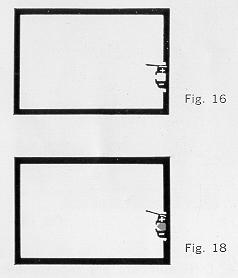 |
| FOCUSING
Release the exposure meter switch and AUTO/MANUAL control on the lens to position (Fig. 19). Turn the distance ring first in one direct then in the opposite direction until microprism in the center of the image in the viewfinder is sharp (Fig. 20). Picture is now focused. The distance scale may also be used for focusing. Estimate or measure the camera to-to-subject distance in feet or in meters, then turn focusing ring. So the figure representing that distance is opposite the index line. |
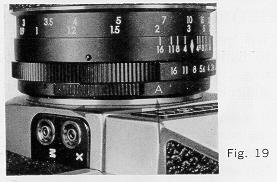 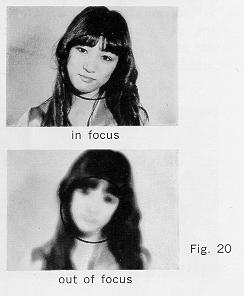 |
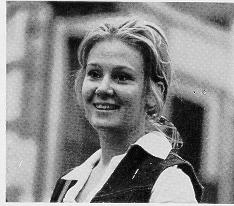
SETTING THE SHUTTER
The length of time for the film to be exposed to light can be adjusted by shutter speed setting. "60" (1/60 second) is recommended for subjects not in motion.
It is recommended to use shutter speeds ranging from 1/125 to 1/1000 for subjects in motion. 1/1000 second speed will best ' freeze" fast action.
The " B " setting can be used for long exposures at night, using street lights or electric signs, or under poor light conditions when flash unit is not used.
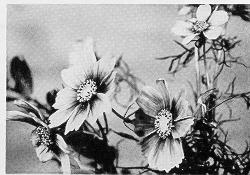
UNLOADING THE CAMERA
When the red figure " 20 " or " 36 " (corresponding to 20- and 36-exposure film) appears in the exposure counter window lined up to the index
mark, the end of the film has been reached.
| Take the following steps for rewinding film into cassette.
(1) Unfold crank on rewind knob (Fig. 21). (2) Press in all the way rewind release button on camera bottom (Fig. 22). |
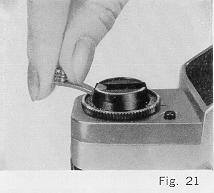 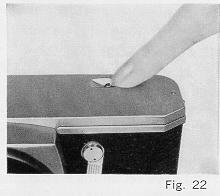 |
|
(B) Depth of Field Scale (Fig. 23)
After setting the lens opening and having focused on your subject, the area of sharpness in front of and behind your subject can be determined on the Depth of Field Scale. Locate on the Depth of Field Scale the same two F numbers corresponding to stop you have set on the F stop ring. The distance between these two F numbers on the focusing scale will be the area of sharpness in your picture. |
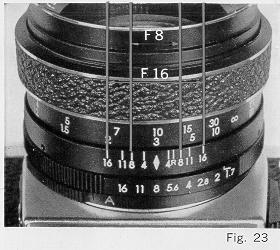 |
|
SELF TIMER
The self-timer permits the photographer to get into the picture. Place camera on tripod or other firm support (tripod socket is on bottom of camera). Get camera ready for exposure as usual. Push down self-timer lever (Fig. 24). |
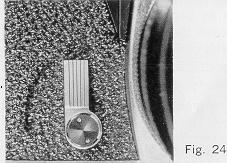 |
|
FLASH PICTURES
Most types of flash bulbs and also electronic flash can be used for flash pictures. When using flash bulb No. 5, 5B, 25, 25B, M5, M5B, M2, M2B, AG1, 6, 6B, 8, connect the flash cord to flash socket " M ". When using electronic flash or SM flash bulbs, connect the flash cord to flash socket "X" (Fig. 25). |
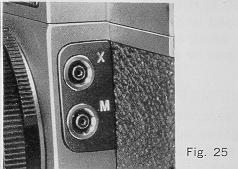 |
|
MULTIPLE EXPOSURE
To superimpose two or more exposures on one negative, support the camera on a rigid tripod to ensure correct framing. Make the first exposure in the normal way, then, without moving film transport lever, slide the multiple exposure lever (Fig. 26) as far as it will go to the left. A red signal appears in its cutout window indicating that the film transport lever can be wound, but will only set the shutter and not transport the film. On releasing, a second exposure is made on the same film frame. This procedure can be repeated to obtain any numb her of exposures on one negative. If the multiple exposure lever has been set but is in fact not required, you can manually push it back to cancel its effect. |
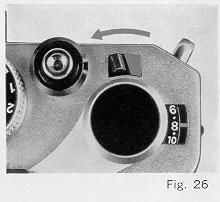 |
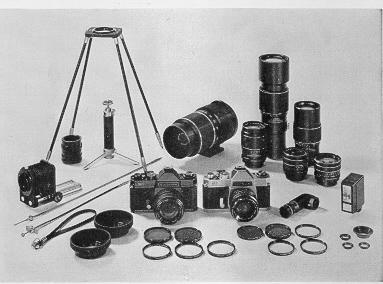
Interchangeable Lenses Accessories
|
28mm F 2.8 AUTO 100m m F 2.8 AUTO 135mm F 2.8 AUTO 200mm F3.5 AUTO 300mm F4.5 AUTO
|
Auto-Extension rings
Mini- Copy stand Table tripod Filter (55m m) IA, UV, Y2, N D4, PL |
|
Cable release (20 inch) Cable release (13 inch) Eyepiece adaptor --2.5 Dioptor Eyepiece adaptor +1.0 Dioptor
|
Rubber lens hood (52mm) Rubber lens hood (55mm) Wrist strap Lens mount cap Eyepiece adaptor +3.0 Dioptor |